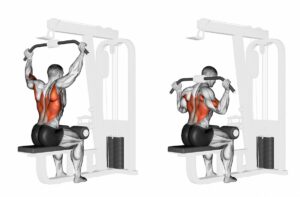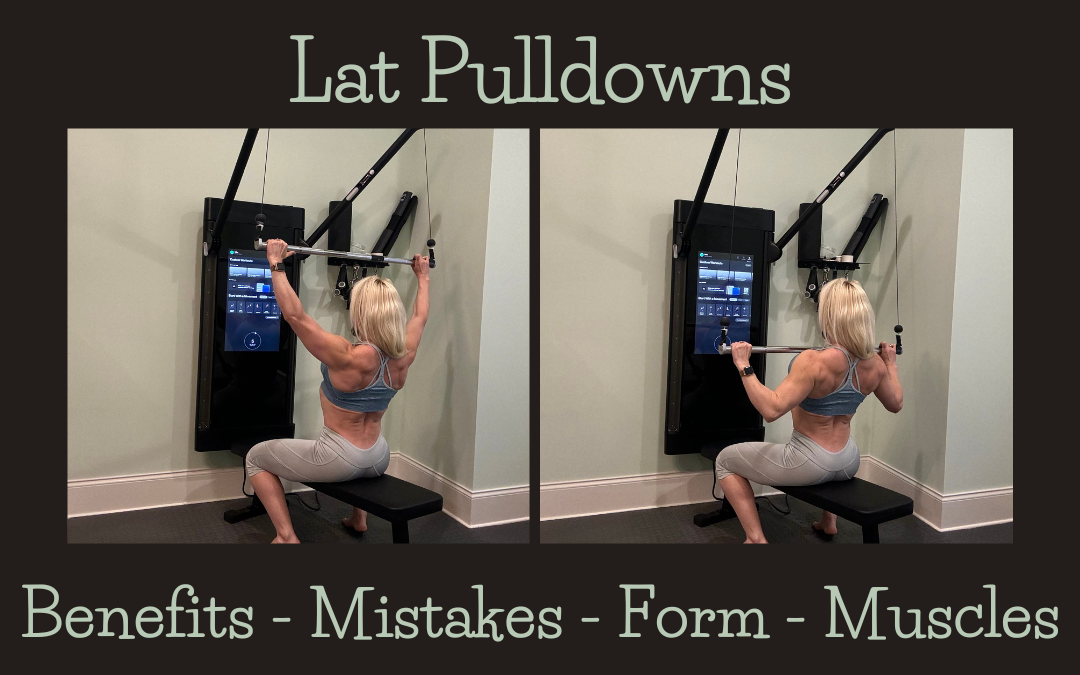The back is a huge area and performing different exercises is essential to strengthen and sculpt this upper posterior region. A great compound exercise that strengthens the back is the lat pulldown. In this guide, I’ll show you the muscles involved in the lat pulldown, how to perform it with proper form, the benefits and mistakes associated with this exercise, the video tutorial on how to do lat pulldowns, and give you ideas to complete your back workout.
What Muscles Do Lat Pulldowns Work?
The back is an extremely important part of the body but many people neglect it. The back is connected to the hips and gluteal muscles at the bottom, to the neck at the top, and to the anterior area of the body through the chest and shoulders. It empowers your body and contributes to basic human movement dynamics.
Overall, the lat pulldown is an effective exercise for developing strength and size in the back, particularly the latissimus dorsi, but it also involves several other muscles to varying degrees.
Primary Muscles:
- Latissimus dorsi: This is the largest muscle in the back that starts under the tail end of the trapezius and goes all the way down to the sacrum, and out onto the posterior iliac crest. It also has some fibers arising from the lower four ribs, and occasionally from the tip of the scapula. It is responsible for various movements involving shoulder extension, adduction, and internal rotation.
Secondary Muscles:
- Rhomboids: Muscles located in the upper back in between the scapula. They support and draw the scapula superomedially, and rotate the glenoid cavity. These muscles, located between the shoulder blades, help stabilize the shoulder blades during the exercise.
- Trapezius: These large paired muscles extend longitudinally from the posterior top of the neck to the middle of the back and laterally from one end of the scapula to the other end). They support the arm and retract, rotate, and depress the scapula. The upper fibers of the trapezius assist in shoulder elevation during the movement.
- Teres major: This small muscle runs along the lateral border of the scapula and is located above the latissimus dorsi. It facilitates shoulder movement and it’s seen as “lat’s little helper” because of its synergistic action with the latissimus dorsi.
- Forearms: Located in the upper limbs between the elbows and the wrists. The forearm muscles are engaged since grip strength and stability are required to hold onto the bar and hold the weight.
- Erector Spinae: Set of muscles that run vertically along the side of the vertebral column, originating at the hip and extending up to the skull. These muscles help rotate and extend the spine and neck.
- Biceps brachii: These muscles on the front of the arm have 2 heads (short and long head) and are engaged, although not primarily, as synergists during lat pulldowns, particularly during the elbow flexion phase of the movement.
Lat PullDown Benefits
Here are all the benefits of performing lat pulldowns:
- Muscle Development: The lat pulldown primarily targets the latissimus dorsi, which is the largest muscle in the back. Strengthening this muscle helps improve overall back definition and width. Having a strong back assists you in developing and strengthening other muscles as well. This translates into increased power for a great variety of movements, such as in ab and chest workouts and exercises for the lower posterior chain
- Improved Posture: Strengthening the muscles in your upper back, including the lats, can help improve posture by pulling the shoulders back and down, counteracting the rounded shoulders often associated with poor posture. Lat pull-downs help correct that forward-head / rounded-back posture. Getting used to the movement helps train your body to bring down (depress) and pull together (adduct) the shoulder blades, giving you a straighter posture and a more confident figure.
- Variety and Versatility: Lat pulldowns offer a variety of grip options (wide grip, narrow grip, reverse grip) which allow you to target different areas of the back and arms, including the upper back, lower back, and biceps.
- Increased Upper Body Strength: By targeting multiple muscle groups including the back, shoulders, and arms, lat pulldowns can help increase overall upper body strength, which can translate to improved performance in other exercises and daily activities.
- Reduced Risk of Injury: Strengthening the muscles in the back and shoulders can help stabilize the spine and shoulders, reducing the risk of injury during other exercises or daily activities.
- Muscle Balance: Incorporating lat pulldowns into your workout routine can help maintain muscle balance between the front and back of the body, which is important for overall strength and function.
- Scalability: Lat pulldowns can be easily scaled to accommodate different fitness levels by adjusting the weight, reps, and sets. This makes them suitable for beginners and advanced lifters alike.
- Convenience: Lat pulldowns can be performed using a cable machine or a dedicated lat pulldown machine, both of which are commonly found in most gyms. This makes them a convenient exercise to include in your workout routine.
- Improved Grip Strength: Depending on the grip used, lat pulldowns can also help improve grip strength, which is beneficial for various exercises and activities both inside and outside the gym.
- Aesthetics: Strengthening and developing the muscles of the back through lat pulldowns can contribute to a more balanced and aesthetically pleasing physique. Lat pulldowns help to give you a V-shape, showing a slimmer-looking waistline.
- Lower Back Stability: Strengthening the lats helps stabilize your lower back. This can help you perform other exercises such as deadlifts, squats, and even chest presses.
- Back Pain: Lat pull-downs help you deal with and prevent back pain since back pain is commonly caused by an unstable lower back.
Lat Pulldown Mistakes
Now that you know all the benefits associated with the lat pulldown, pay attention to your form so you can avoid the most common mistakes associated with this exercise:
- Using Too Much Weight: Many people load up the lat pulldown machine with too much weight, sacrificing form for heavy lifting. This not only decreases the effectiveness of the exercise but also increases the risk of injury.
- Arching the Back: Arching the back excessively during the movement can lead to hyperextension and strain on the lower back. It’s important to maintain a slight arch in the lower back while keeping the core engaged throughout the exercise.
- Pulling the bar behind the neck: People used to perform lat pull-downs behind the neck. However, this variation can cause injuries and avoid targeting the lats properly. You should always keep the bar in front of you. If you experience neck or back pain due to improper form, you need to stop immediately. Schedule enough rest to reduce soreness, using CBD pain cream and warm compresses to manage the pain. If the pain doesn’t disappear within days, you may need to book an appointment with your doctor to ensure you haven’t caused a serious injury.
- Bringing the bar down below your chest, allowing the elbows to point back: This removes the tension from the lats and causes the shoulders to come forward. Not only removes the tension from the back but it can cause injuries.
- Incorrect Grip Width: Grip width plays a significant role in which muscles are targeted during the exercise. Using a grip that is too wide or too narrow can shift the emphasis away from the lats and onto other muscles like the biceps or shoulders.
- Pulling with the Arms: Instead of engaging the back muscles to initiate the movement, some people rely too heavily on their arms to pull the bar down. This reduces the activation of the lats and can lead to overuse injuries in the arms.
- Incomplete Range of Motion: Failing to fully extend the arms at the top of the movement or failing to bring the bar down low enough to fully engage the lats can reduce the effectiveness of the exercise. Aim to fully extend the arms at the top and bring the bar down until it’s just above chest level.
- Over-emphasizing the forearms: Make sure that your lats are pulling the bar down, not your forearms. Activate your back by pulling down from your armpits.
- Using momentum: Bouncing, jerking, or swinging the bar uses momentum to pull the bar down. Rather focus on using a controlled, smooth motion throughout the entire movement to increase lat engagement and the effectiveness of the exercise and to decrease the risk of injury. If you are using momentum to move the weight, you need to use a lighter weight.
- Grabbing the bar too wide: Being too wide shortens the range of motion and can irritate the shoulder joint.
- Not Breathing Properly: Forgetting to breathe or holding your breath can increase intra-abdominal pressure and reduce stability. Remember to exhale as you pull the bar down and inhale as you release it back up.
How to Do Lat Pulldowns

- Approach the lat pulldown machine and sit down. Adjust the thigh pad so that it fits snugly over your thighs and plant your feet firmly on the ground. This helps prevent you from lifting off the seat when pulling down.
- Grasp the bar with an overhand grip (palms facing away from you) slightly wider than shoulder-width apart. Alternatively, you can use a different handle attachment for variation. Your arms should be fully extended, but not locked out.
- Before starting the movement, engage your core, keep your chest tall, and stabilize your shoulder blades by pulling them down and back.
- Move your upper back slightly backward and keep a tall neutral spine.
- Exhale as you pull the bar down towards your chest by flexing your elbows and squeezing your shoulder blades together.
- Aim to bring the bar to the upper part of your chest, just below your chin. Keep your chest up and your torso stationary throughout the movement.
- Pause for a moment at the bottom of the movement, squeezing your back muscles.
- Inhale as you slowly release the bar back to the starting position, fully extending your arms without locking out your elbows. Maintain control throughout the movement.
- Repeat
*️⃣ You can perform lat pull-downs in diverse ways. You can switch the grip from neutral, as delineated above, to a close or wide grip. You can also switch from an overhand grip to an underhand grip (reverse grip pull down). Additionally, you can switch the long bar for a D-handle, a short handle, or a V-handle.
If you don’t have access to a lat pull-down machine, you can also perform a variation using dumbbells: Bent Over Pulldowns.
Lat Pulldown Video Tutorial
Back Workout
You can complete your back workout by performing the following exercises:
Strengthening your back muscles is not a luxury but a necessity. Back muscles help keep the joints of the spine free from restriction and strong back muscles help you to develop and maintain correct posture. This is significant since improper posture leads to back pain over time. Strengthening your back muscles with the lat pulldown and avoid the most common mistakes described above.
Lift, Burn more Fat, Get Stronger, and Live Healthier!
To a Fitter Healthier You,
The Fitness Wellness Mentor



